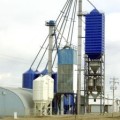Since the first rectangular, pitched-roofed elevator was erected in 1881 to handle the fall harvest at Gretna, Manitoba, grain elevators have been to the Prairies what high-rise office towers are to Canada's large urban centres. More than mere storage bins for prairie grain, these towers on Canada's flat lands -where the horizon stretches as far as the eye can see- are beacons on the skyline and gathering points for conducting business and debating the news of the day. Grain elevators, which are generally owned and operated by grain-buying companies, are constructed to elevate grain to bins within the building, from where it can be piped, via gravity, to waiting railway cars for export. They also serve as points of sale for fertilizer and seed. But like cabooses and lighthouses, traditional grain elevators are disappearing, victims of a new way of doing things in Canada's grain belt. In 1933-34, nearly 5,500 primary elevators dotted Alberta, Saskatchewan, Manitoba and parts of British Columbia. Today, fewer than 1,000 remain, many abandoned and awaiting demolition. "On a quiet day in Calgary," muses one historian, "you can hear the sound of elevators crashing down in the country." From the foothills of Alberta to Manitoba's great plains, these postcard-pretty buildings have been pushed toward extinction by the abandonment of railway branch lines and by the rationalization of Canada's farms and grain-handling system. Their fate has also been sealed by mammoth superterminals that can store more than 10 times the grain, fill rail cars more quickly and clean grain more cost-effectively than their inefficient wooden ancestors.
Since grain elevators began tumbling like dominoes in the early- to mid-1970s, the physical, social and economic landscape of the Canadian Prairies has been profoundly altered. In dozens of communities like Lewvan, Saskatchewan and Austin, Manitoba, the one vertical element that rose above the horizontal plain has become endangered.
Each time an elevator is abandoned, a familiar small-town focal point is lost, a place where for generations farmers gathered in spring to buy seed and fertilizer, and in fall to sell their harvests, discuss prairie politics, chat about weather and grain prices and weigh the fortunes of the local sports teams.
With no local elevators, growers now take their crop and their spending power to larger centres, often with devastating consequences for small towns: cafes and storefronts are boarded up, residents leave in search of new jobs, and once-thriving prairie communities fade away.
Although many a tear has been shed as towns lose the vintage elevators that have towered over their main streets -- in many cases for more than a century -- the loss is not universally felt across the Prairies. A handful of larger centres have reaped the benefits of the futuristic concrete grain terminals that are reshaping the look and economics of the Prairies. Silo-shaped and costing as much as $15 million, these towering giants have created jobs and pumped millions of dollars into the region. As of July 1999, there were 28 of these newer high-volume elevators with capacities of 20,000 tonnes or greater.

